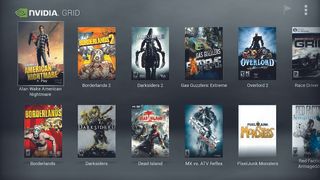Game Streaming 101
Can I Stream My Games?
Which games will work, and on which devices?
There are no hard and fast rules to determine which games are best suited to streaming, but there are some guidelines to follow to minimize frustration. If you’re streaming from one PC to another PC (or another device with a mouse and keyboard), the network is arguably the most important link in the chain, because the control scheme is identical. For best results, the host PC should be wired. If that’s not possible, the wireless connection needs to be strong and reliable—an 802.11n or 802.11ac 5GHz router/access point should be a requirement, though a good 802.11g router will technically work as well.
The game’s preferred input method is also a major consideration. Nvidia has a huge list of games posted online that it’s certified as compatible with its GameStream technology (http://bit.ly/1wJigAm), which also illustrates what types of controllers are supported. What you’ll find is that many games support multiple controllers, but a particular type would be ideal for certain games. For example, shooters work best with a mouse and keyboard or maybe a game controller, but they’re less suited to touchscreens. Conversely, racing and sports games are perfectly playable with a game controller or touchscreen, but a keyboard and mouse aren’t quite as intuitive.
Testing Times
Then again, preferred input methods are subjective. Less subjective is our tolerance for latency. When the latency between the game server (the system running the game) and client (the one receiving the stream) is too high, the experience won’t be good.
Ultimately, the games best suited to streaming are those compatible and playable with multiple controller types. GameStream and In-Home Streaming are compatible with a wide range of titles in all genres, but game streaming isn’t universally possible across all games and systems/devices. “To enable a GameStream game, Nvidia has to test each game in our lab,” Nvidia’s Andrew Fear, product manager for GRID, told us. “We leverage all of the testing that goes into the GeForce Experience optimal playable settings to develop profiles for each game we support.
“In addition, we have to test games to ensure they start up flawlessly and don’t show any strange dialog boxes during gameplay. It’s a big undertaking to do this for hundreds of games, but we are committed,” Fear says. Some of the testing involves general compatibility, but Nvidia also ensures its Shield controllers are mapped properly, that the game’s interface works and is displayed properly when streamed, and that the experience is generally good. Games not listed may still work properly, but they haven’t been officially tested yet.
The Future of Game Streaming
Could single-platform games become a thing of the past?
For game streaming to go mainstream and become one of the preferred methods for gamers to get their fix, many things need to improve. Should all of the stars align though, there could be serious implications for the PC gaming industry. By its very nature, game streaming somewhat negates the need for gamers to own their own powerful PC or game console. A system of some sort capable of actually running the game must be available at some stage of the pipeline—most likely in the cloud—but the gamer’s device receiving the stream need only have the ability to connect to a network, accept user input, and playback the game video.
Theoretically, streaming games from the cloud could obliterate the consumer addin GPU market. So, you’d think AMD and Nvidia would despise the technology, but they don’t. GPUs are still needed to render a game, whether it be local or in the cloud. And ideally, each game being streamed would have adequate GPU resources allocated to render it in the highest quality and for each gamer connected to the service. To that end both AMD and Nvidia have developed boards strictly for use in game streaming servers that can be virtualized to support multiple game instances simultaneously.
The biggest gaming news, reviews and hardware deals
Keep up to date with the most important stories and the best deals, as picked by the PC Gamer team.
So, even though streaming could cannibalize local PC gaming, there’s still huge potential for GPU makers and a need for significant GPU resources. They just may not live under your desk in the future—they’ll be in the cloud.

Games will be rendered by a GPU in the cloud, rather than one under your desk.
The Cloud's the Limit
When we asked Nvidia how it sees game streaming evolving in the future, it answered with, “Nvidia is committed to giving users as many choices with their games as we can. We are gamers; we enjoy games on many different platforms and usage models. We want to give Nvidia customers choices: they can enjoy local PC games on their own GeForce PC, they can stream the games they own using GameStream, or they cannot even own a PC and stream games from GRID to a Shield.” And that’s really the crux of the issue and why game streaming is being actively pursued by so many players. Game streaming could ultimately give gamers more choice and developers more fl exibility.

Nvidia is prepping its GRID service to stream PC games from the cloud, with excellent image quality and minimal lag.
As things stand, we usually have to buy games for a particular platform, be it the PC, Android, an Xbox, smartphone, or whatever. Developers also have to make the games for each platform. There are plenty of assets that can be carried over for each version, but developing and tuning a game for multiple platforms still requires a considerable amount of time and effort. If game streaming becomes the norm, developers may only have to develop and optimize a game for a single platform and gamers would play it on their preferred device. This scenario could change the way we buy games as well. Instead of buying a game for one platform, we’d simply be buying access to a particular game that can be played on any platform. We could play our games virtually anywhere and have all of our stats and save-games come with us.
A number of the existing cloud gaming services already give us a glimpse of this future. Nvidia’s GRID or Sony’s PlayStation Now betas allow gamers to play games—in these cases PC games (GRID) or PlayStation 3 games (Now)—on portable Android devices or other Sony gaming systems. But make no mistake, there’s no technical reason limiting these services (and others) from working properly on virtually any device, from a smart TV to a smartphone.

In a single-platform world, developers could be more flexible and creative.
Console vs PC vs Streaming
Consoles could be heading for the cloud
Game streaming has the potential to seriously disrupt the game console and PC businesses. The SoCs in many of today’s smart TVs are already powerful enough to run the client software necessary to stream games from the cloud, and they’ve got capable video engines and network connectivity already built in, too. There could come a time when a powerful PC or a dedicated game console is no longer necessary to enjoy the latest games.
A lot still has to happen before that becomes a reality, however. The state of broadband in the U.S. (and many other countries) leaves a lot to be desired, and a fast, reliable broadband connection is paramount. Game streaming services must also evolve to the point where they can offer reliable, low-latency connections to all of their potential customers. And then there’s the business model to consider—game developers and streaming service providers need to offer a product to gamers that’s both affordable and enjoyable, that can also sustain the business. These aren’t insurmountable hurdles by any means, but they aren’t going to be resolved overnight.
We think gaming PCs will remain popular for years, however, and so does Nvidia. “We believe there will always be a place for local PC experiences with GeForce and remote game experiences with GameStream or GRID,” said Andrew Fear. “But the power of our streaming technology does allow us to bring our entire library of GeForce-optimized PC games to a brand new platform,” he added.
Panic Over
Bottom line: A powerful gaming PC is and will remain the premiere gaming platform—bar none—and hardcore gamers aren’t likely to give up all of the benefits of local gaming anytime soon. Consoles will probably be around for another cycle or two as well, but Sony and Microsoft are already developing cloud-based services, so it’s possible next-gen consoles may be much smaller, thinner, and potentially less-powerful devices that rely on the cloud for everything from content delivery to rendering. We wouldn’t be surprised if the next wave of “consoles” are actually licensed to television manufacturers that would integrate the necessary processors and input mechanisms directly into the televisions themselves. Time will tell.
As network speeds and capacities increase, and hardware becomes more powerful, game streaming services will continue to improve. There will probably come a time when game streaming offers an almost indistinguishable experience from gaming locally, but even if it doesn’t, the allure of accessing games from virtually anywhere, on any device, will be compelling and we suspect gamers will flock to the services in droves. If (or when) that happens, the demand for high-performance gaming systems, packed with cutting-edge hardware, will be diminished greatly.
Most Popular


